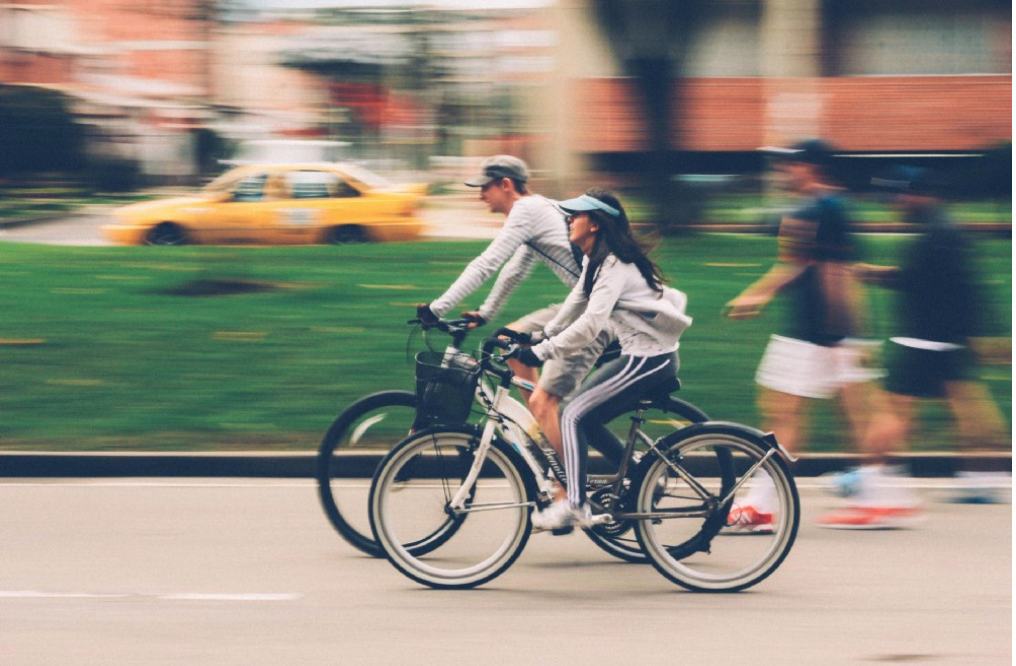
This article looks at plans to “design” safety into Toronto’s streets based on a set of design-for safety principles.

Key benefits of incorporating active travel for businesses (and how MaaS can help)
We all know the benefits of walking, cycling and moderate exercise from the potential to reduce heart problems and obesity and counteract depression to generally lowering the risk of death. The World Health Organisation (WHO) estimates there are one million deaths (10%) each year in the European Region which are due to lack of physical exercise, so it bears close attention.
The fact is, we’ve become more sedentary over the years with many people doing little to no exercise. According to the WHO, ‘Recent figures from member states of the European Union (EU) indicate that 6 in every 10 people above 15 years of age never or seldom exercise or play a sport and more than half never or seldom engage in other kinds of physical activity, such as cycling, dancing or gardening’.
Not only is the lack of exercise impacting health and well-being, it has a knock on effect for businesses too. According to the UK Government, in 2016/17 ‘1.3 million workers suffered from work-related ill-health, which equated to 25.7 million working days lost. This has been estimated to cost £522 per employee, and up to £32 billion per year for UK business’. However, there’s a great deal that organisations can do — introducing, for example, active travel which not only benefits the organisations but also the employees.
What is active travel?
Active travel is defined as making a journey through our own human efforts. This could be walking or cycling or equally it could be skateboarding, roller-skating or any other mode of physical transport. If you walk to work or are a commuter cycling to the train station, you’re engaging in active travel.
Government bodies and councils are looking to encourage this mode of getting from A to B. The UK Local Government Association, in itsSustainable Travel research, surveyed 38 councils, the results of which highlighted ‘reducing traffic congestion’ and ‘improving public health and fitness’ as the two main drivers for investing in sustainable travel. Thirty-five of the 38 councils that responded had already ‘provided secure cycle parking and/or changing facilities and 35 had promoted cycling and/or walking through schools’.
The benefits for business
So how does it benefit business? In quite a few ways, as it happens. Having an active travel policy can help to counteract many issues businesses face as a result of employee health. Here are some of the key positive takeaways:
1) Improved employee health and well-being
Moderate exercise, as we mentioned earlier, can have great benefits for an employee’s well-being. They’re also less likely to be absent from work due to sickness. A survey carried out by Sustrans found that ‘…people who cycle on the National Cycle Network found they take nearly half as many sick days as the average UK worker.’
2) Increased productivity
Healthier staff are generally more productive and more mentally alert. In fact, research by Mercer highlights that, ‘10.6 days of productive time per employee could be saved by improving the health of an average workforce.’ In a 100-employee company it equates to ‘the productive input of another 4.7 people’. That extra capacity could really make a difference for many organisations.
3) Reduced car parking
An article by Sustrans commented that in Japan, due to the densely populated urban areas, citizens don’t own a car but use a combination of public transport and bikes for their travel. As a result, fewer cars on local roads make it easier — and more attractive — to walk or cycle, with the modal share for bikes being as high as 30% in some neighbourhoods.
This is great to see. Of course, much of this also relies on government intervention. However, the Cycle to Work scheme is just one way that organisations can incentivise staff to get involved in active travel. Introduced by the UK Government in 1999, it provides tax-free benefits for employees on cycling gear so it’s at no real cost to the business.
Plus, it means there’s less need for car parking — which could become an increasing cost for businesses. The possibility of a levy on car parking spaces is increasingly being considered by Governments and is something that Scotland is looking to introduce, following the lead of Nottingham according to the BBC.
4) Attracting and retaining employees
Many people want to work for a business that makes a social impact. This could be one way of attracting great talent — including Gen Y and Gen Z who will make up over 50% of the workforce by 2020, according to research by Manpower Group. Indeed, in theDeloitte Millennial Survey 2018, it found that the younger workforce wanted business leaders ‘to take the lead in solving the world’s problems, to shift organizations’ motives from inordinately focusing on making profit to balancing social concerns…’
5) Supporting the community and environment
For that reason, active travel can be a key part of an organisation’s corporate social responsibility strategy as it also reduces congestion and carbon emissions in the community. Everyone wins. According to a report byTransport & Environment, ‘Transport is Europe’s biggest source of CO2, responsible for the emission of over a quarter of all greenhouse gases.” That’s a massive impact on our health and communities.
How can businesses get involved?
Take part in the Cycle to Work scheme, provide showers and cycle storage on site, encourage people to go for walks at lunchtime to get away from their desks — these are just a few of the options open to organisations.
The use of Mobility as a Service (MaaS) apps can also help organisations integrate active travel into the business. These apps combine the different modes of transport to make it easier for employees to include, for example, walking and cycling into their work life. There are several ways they can do this:
1) Prioritise chained trips
MaaS apps allow employees to prioritise chained trips for low carbon emissions and calories. Not only will they see the number of calories they’ll burn but also carbon emissions saved. This helps to raise awareness and provide transparency so they can see the impact of the journeys they make.
Example of cycle friendly trip chain, created with our TripGoapp.
2) Set walking speed
The ability to set their walking speed to slow, medium or fast offers a more tailored experience, providing a realistic journey — and less frustration. People can walk at their own pace. This goes hand-in-hand with the previous point and hopefully leads people to want to walk more.
3) Routing for bicycles
Where data is available, MaaS apps can offer bicycle routing with other helpful information such as how ‘bike friendly’ the terrain is. This is a big win for the cyclists in your business.
Likewise, it can also show which public transport accommodates bikes. This makes it easier for employees to plan their first and last mile to integrate cycling into their multi-modal journey.
4) Wheelchair accessibility
Accessibility features, such as wheelchair friendly routing provides wheelchair users with more information about the route they intend to make. This means they’re better able to move around independently and take public transport for example, rather than relying on cars only. By providing this information, it offers the wheelchair users within your business additional travel options with greater ease.
Whilst we all have to take responsibility for our own health, there’s a lot that businesses can do to help their employees. Using some of the options outlined in this article, along with MaaS apps, it’s possible to make active travel such as walking and cycling easier and more appealing.
By displaying them as mode options and communicating more clearly the health and environmental benefits, it increases both visibility and potential attractiveness of these options. It all starts with taking a different approach to the way we view travel so that we can encourage healthier, happier communities and workplaces along the way.
London Mayor Sadiq Khan outlines in his Transport Strategy why creating a more ‘liveable’ city, one which caters to the longer-term needs of its citizens is so important: “Doing this will be vital to making London a fairer, greener, healthier and more prosperous city. A city that is not only home to more people, but a better place to live. A city where transport is affordable, reliable and accessible for all Londoners. And a city where the best, easiest and most convenient transport choice will increasingly be the active travel choice.”
Sandra Witzel, Head of Marketing for SkedGo, will be running a workshop on ‘incorporating active travel into business’ at the Open Mobility Conference 2019 which takes place on Thursday 11th April 2019 in Brussels.
Photo by Nubia Navarro (nubikini) from Pexels



Recent Comments